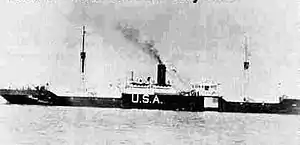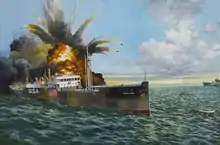SS Robin Moor
SS Robin Moor was a Hog Islander steamship that sailed under the American flag from 1919 until being sunk by German submarine U-69 on 21 May 1941, before the United States had entered World War II, after allowing the passengers and crew to board lifeboats.
 | |
| History | |
|---|---|
| Name: | SS Robin Moor |
| Operator: | Seas Shipping Co Inc, New York |
| Builder: | American International Shipbuilding Corp., Hog Island |
| Completed: | 1919 |
| Fate: | Torpedoed and shelled on 21 May 1941 |
| General characteristics | |
| Type: | Design 1022 cargo ship |
| Tonnage: | 4,999 tons |
| Crew: | 46 |
This sinking of a neutral nation's ship in an area considered until then to be relatively safe from U-boats, and the plight of her crew and passengers, caused a political incident in the United States. On the 75th anniversary of its sinking, the American Merchant Marine Museum in Kings Point, New York, opened an exhibit on the sinking of Robin Moor entitled "How to Abandon ship."
Construction, prior names, and owners
The ship was completed in 1919 by the emergency shipbuilding works of American International Shipbuilding Corp. at Hog Island, just outside Philadelphia. She was a "Hog Islander," the name for the class of ugly but sturdy merchant vessels built at the works during that period. She was laid down as Shetucket, and completed as Nobles. In 1928 she was renamed Exmoor for American Export Lines Inc, of New York. In 1940 she was sold to Seas Shipping Co. Inc., of New York, and renamed Robin Moor.
Her sinking

In May 1941 Robin Moor was carrying nine officers, 29 crewmen, eight passengers, and a commercial cargo from New York to Mozambique via South Africa, without a protective convoy. The ship held "items of every conceivable description that would go into a general cargo", including over 450 autos and trucks, steel rails, tools, agricultural chemicals, over 48,000 U.S. gallons (180,000 L) of lubricant in drums, cases of shotgun shells, and a few .22 caliber rifles destined for sporting goods stores.[1]
On 21 May, the ship was stopped by German submarine U-69 in the tropical Atlantic 750 miles west of the British-controlled port of Freetown, Sierra Leone. Although Robin Moor was flying the flag of a neutral country, her mate was told by the U-boat crew that they had decided to "let us have it."
After a brief period for the ship's crew and passengers to board her four lifeboats, the U-boat fired a torpedo at the rudder and then shelled the vacated ship at the bridge. Once the ship disappeared beneath the waves, the submarine's crew pulled up to Captain W. E. Myers' lifeboat, left him with four tins of pressed black bread (which "the lifeboat passengers found ... too tough to eat")[2] and two tins of butter, and explained that the ship had been sunk because she was carrying supplies to Germany's enemy.
The actions of Metzler of U-69 caused many to question his motives since Hitler himself, preparing for a June invasion of Russia, had specifically instructed his Navy chief, Admiral Erich Raeder: "...in the next weeks all attacks on naval vessels in the closed area should cease..." Hitler did not wish to provoke America into joining with Britain in its fight against Germany. Source: "'Outrageous and Indefensible'/The Sinking of the SS Robin Moor, 1941", revised edition, George Haber.
Eventual rescue
When Robin Moor was stopped, the Germans had forbidden the ship's crew to touch their wireless, but after the sinking, U-69's captain, Jost Metzler, reportedly promised the ship's crew to radio their position.[2] The captain kept the lifeboats near Robin Moor's position for 24 hours, then navigated towards St. Paul's Rocks or the Brazilian coast with all four lifeboats bound together.[3] The captain split the lifeboats apart on 26 May as that strategy wasn't working.[4]
The lifeboat containing the captain and 10 others was rescued on 8 June after 18 days by the Brazilian merchant ship Osório with their rescue radioed from Osório to the Brazilian ship Lages, from there to the US merchant ship Deer Lodge, and from there to RCA which relayed it to Washington D.C.[5] Osório then went to Pernambuco where Brazil allowed US ambassadors to interview the rescued survivors first. On 14 June, the Maritime Commission asked ships in the area of Robin Moor's sinking to be on the lookout for survivors, though the New York Times stated "Little or no hope is held out" for the remainder of the survivors.[4][6]
On 13 June, two Connecticut residents independently stated they heard short-wave broadcasts from Italy that a submarine had docked at an Italian port and contained eight survivors from Robin Moor.[7] This proved to be unfounded. The occupants of the rescued lifeboat presumed that the remaining crew and passengers were lost, but the others had been discovered on 2 June and taken to South Africa by the cargo vessel SS City of Wellington. City of Wellington (later sunk by a U-boat in August 1942) was operating under radio silence, but were able to receive the news that the captain's party was rescued and those rescued by City of Wellington were presumed dead. The City of Wellington survivors landed in Cape Town on 18 June and their rescue was immediately in the news.[8] All of the crew and passengers were rescued. The Brazil contingent returned to America via SS Delargentino.[2]
Aftermath

Isolationist United States Senator Gerald Nye, blaming Britain for sinking Robin Moor, said he would be "very much surprised if a German submarine had done it because it would be to their disadvantage" to torpedo the ship.[8][9]
On 11 June, The New York Times, reporting several different rumors pointing to German blame, also said there may have been Italian submarines in the area, and quoted a German source that said the reports were "confusing, unclear, and contradictory."[10]
Nye withdrew his comment on 14 June 1941, stating "The evidence that the Robin Moor was sunk by a German submarine is too complete to permit my declaration of yesterday noon, to the effect that the boat might have been sunk by Britain, to stand", through the America First Committee.[11]
President Roosevelt later stated in a message to Congress regarding the sinking that the survivors were "accidentally discovered and rescued by friendly vessels. This chance rescue does not lessen the brutality of casting the boats adrift in mid-ocean."[12] Senator Theodore F. Green (D-RI) stated "I don't think the sinking will have any more effect than the sinking of The Panay by Japan. An act of war is bilateral, not unilateral." Also speaking about the Panay incident, Representative Melvin J. Maas (R-MN) said "Japan... not only failed to rescue survivors but machine-gunned them afterward and we didn't go to war."
Senator Pat McCarran said "It is nothing to get excited about". Senator Ralph O. Brewster said "The effect of the sinking depends on the attitude of Germany — whether it is a determined policy or an accident". U.S. Representative John William McCormack said "It was very unfortunate but there is no reason now to get unnecessarily excited over this incident". Representative Andrew J. May, chairman of the House Military Affairs Committee, said "We ought to convoy with battleships and let the shooting start and see who shoots first and who can outshoot".[4]
While President Roosevelt responded to the sinking with strong words, the strength of his administration's actions was disputed. His message to Congress described Germany's decision to sink the ship as "a disclosure of policy as well as an example of method." His message concluded:
In brief, we must take the sinking of the Robin Moor as a warning to the United States not to resist the Nazi movement of world conquest. It is a warning that the United States may use the high seas of the world only with Nazi consent. Were we to yield on this we would inevitably submit to world domination at the hands of the present leaders of the German Reich. We are not yielding and we do not propose to yield.
— Franklin D. Roosevelt[12]
German assets were frozen on 12 June, then on 14 June[8] the State Department required Germany and Italy to close all of their consulates in the United States except for their embassies, prompting Germany to issue the same directive to the United States in return. The US also demanded damages and reparations from Germany, without success.
In Congress, isolationist Senator Burton K. Wheeler) claimed that 70% of the ship's cargo constituted the kind of materials meeting both German and British standards for contraband, defended the legality of Germany's right to destroy her, and characterised Roosevelt's message as an effort to bring the United States into the war. Others, such as Senator Claude Pepper, urged their colleagues to require the arming of merchant vessels.
In October 1941, federal prosecutors in the espionage case against a group of 33 defendants known as the "Duquesne Spy Ring" adduced testimony that Leo Waalen, one of the 14 accused men who had pled not guilty, had submitted the sailing date of the Robin Moor for radio transmission to Germany, five days before the ship began her final voyage. Waalen and the others were found guilty on 13 December 1941.
In literature
John J. Banigan, the Third Officer of SS Robin Moor, went on to write How to Abandon Ship (ISBN 0870333887), which details his experience and serves as a survival guide for sailors serving in a wartime environment.
References
- "Robin Moor Cargo Analyzed By Line: Company Head Says There Was Not an Item to Which The Reich Could Rightfully Object". New York Times. 14 June 1941. p. 3. Retrieved 7 June 2016.
- "Armed German Seized Ship Radio, Robin Moor's Chief Cook Declares (Associated Press)". New York Times. 14 June 1941.
- "Text of Consul's Report on Robin Moor". New York Times. 13 June 1941. p. 6. Retrieved 7 June 2016.
- "Nazis 'Undoubtedly' Sank the Robin Moor, Aware She Was a U.S. Ship, Consul Says". New York Times. 13 June 1941. p. 6. Retrieved 7 June 2016.
- "U.S. Ship Sunk in Atlantic, Reported Victim of U-Boat". New York Times. 10 June 1941. pp. 1, 7.
- "Robin Moor Raid is held violation". New York Times. 14 June 1941. p. 1,3.
- "Reports More Survivors". New York Times. 13 June 1941. p. 6.
- Schaffer, Amanda. "Lost at Sea on the Brink of the Second World War". The New Yorker. Retrieved 7 June 2016.
- "Nye Would Study Sinking Evidence". New York Times. 13 June 1941.
- "Roosevelt Urges Delayed Judgment on Sinking of Ship". New York Times. 11 June 1941. pp. 1, 5. Retrieved 7 June 2016.
- "Nye Withdraws Comment: Says Evidence now shows that Nazis sank Robin Moor". The New York Times. 14 June 1941. p. 2.
- John T. Woolley and Gerhard Peters, The American Presidency Project "66 - Message to Congress on the Sinking of the Robin Moor". University of California. 20 June 1941. Retrieved 7 June 2016.
Further reading
- Stewart Atkins, "Robin Moor Survivor, on Visit in County, tells a Vivid Story of Incident", Gastonia Daily Gazette, 1 August 1941, at page a-1
- George Haber, 'Outrageous and Indefensible: The Sinking of the SS Robin Moor, 1941' Kings Point, NY: American Merchant Marine Museum, 2016; ISBN 978-0-9975687-0-7.
- United Press, [NewspaperArchive.com "Reparations held unlikely"], Oakland Tribune, 22 June 1941 at page 1
- United Press, "Roosevelt Supporters Urge Arming of US Merchant Vessels", Oakland Tribune, 22 June 1941 at page 4.
- Associated Press, Alleged Spy Accused of Tip on Robin Moor, Salamanca Republican Press, 1941-10-18, at 10, available at NewspaperArchive.com.
- Amanda Schaffer, "Lost At Sea On The Brink Of The Second World War", The New Yorker; accessed 12 December 2016.
